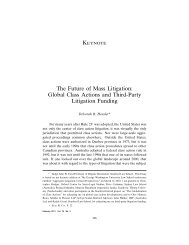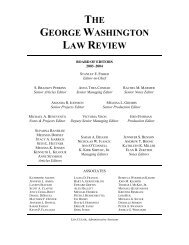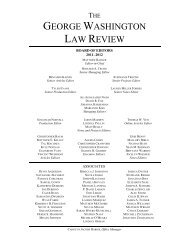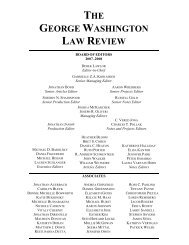View PDF - The George Washington Law Review
View PDF - The George Washington Law Review
View PDF - The George Washington Law Review
You also want an ePaper? Increase the reach of your titles
YUMPU automatically turns print PDFs into web optimized ePapers that Google loves.
2010] Oral History and the Study of the Judiciary 851<br />
on the understanding that we can appreciate the value of the products<br />
of oral history only after having a firm appreciation for oral history’s<br />
methodological strengths and weaknesses. Part II reports the results<br />
of my review of three oral histories provided by the late Judge<br />
Thomas Fairchild of the Seventh Circuit, one of which was among<br />
those reviewed by Domnarski. Part III then turns to Federal Judges<br />
Revealed. It provides a brief overview of the book and an assessment<br />
of its contribution to the study of judges and the judiciary.<br />
I. Oral History Methodology<br />
One of the things that is absent from Federal Judges Revealed is<br />
any sort of extended consideration of oral history as a methodology.<br />
As a result, before digging into the book’s specifics it is worth taking a<br />
moment to think about the nature of oral history and how we might<br />
responsibly use the information that we glean from oral histories.<br />
That, in turn, requires some consideration of the nature of oral histories,<br />
their methodology, and the limitations that this methodology<br />
might impose on future uses of the material.<br />
Oral history as a methodology, like all other methodologies, has<br />
its limitations. For one thing, the term “oral history” seems to have no<br />
defined content except at a relatively broad level. In the words of one<br />
historian, “[s]imply put, oral history collects memories and personal<br />
commentaries of historical significance through recorded interviews.<br />
An oral history interview generally consists of a well-prepared interviewer<br />
questioning an interviewee and recording their exchange in audio<br />
or video format.” 25 As another historian put it, the “basic<br />
dynamic” involves simply “two people sitting and talking about the<br />
past.” 26 <strong>The</strong> lack of a precise definition of oral history does not mean<br />
that anything goes. Professional oral historians have developed techniques<br />
and guidelines for the interviewing process, and a failure to<br />
follow these can result in a product of little or no usefulness. 27<br />
Within the discipline of history, oral history has been criticized<br />
both in terms of its overall usefulness as an approach and its reliability<br />
at a narrower level. 28 <strong>The</strong> former sort of critique arises to a large de-<br />
25 DONALD A. RITCHIE, DOING ORAL HISTORY: A PRACTICAL GUIDE 19 (2d ed. 2003).<br />
26 See Rebecca Sharpless, <strong>The</strong> History of Oral History, in HANDBOOK OF ORAL HISTORY<br />
19, 38 (Thomas L. Charlton et al. eds., 2006). Thus, “[d]espite the sophistication of analysis and<br />
interpretation, a middle-school student can still do a legitimate oral history interview.” Id.<br />
27 See RITCHIE, supra note 25, at 84–109 (outlining techniques for conducting interviews);<br />
id. app. at 252–55 (reprinting the “Principles and Standards of the Oral History Association”).<br />
28 See Sharpless, supra note 26, at 30.



